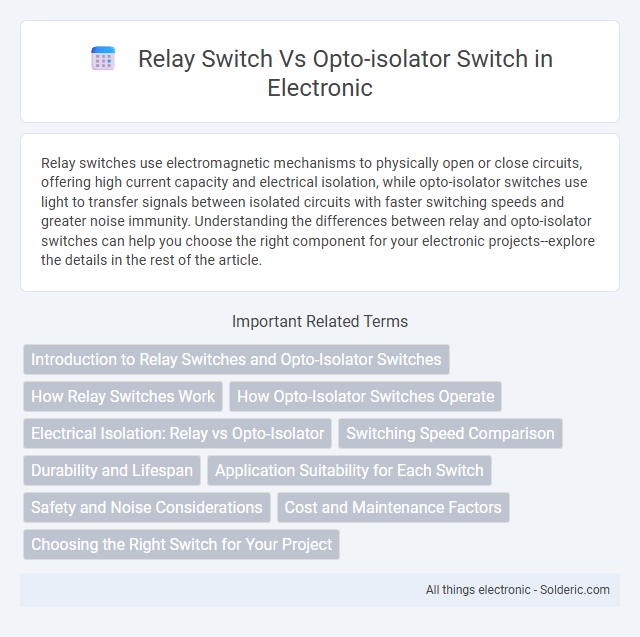Relay switches use electromagnetic mechanisms to physically open or close circuits, offering high current capacity and electrical isolation, while opto-isolator switches use light to transfer signals between isolated circuits with faster switching speeds and greater noise immunity. Understanding the differences between relay and opto-isolator switches can help you choose the right component for your electronic projects--explore the details in the rest of the article.
Comparison Table
| Feature | Relay Switch | Opto-Isolator Switch |
|---|---|---|
| Operation Type | Electromechanical | Electronic (Light-based) |
| Isolation Method | Magnetic isolation via coil and contacts | Optical isolation using LED and phototransistor |
| Switching Speed | Slower (milliseconds) | Faster (microseconds to nanoseconds) |
| Contact Wear | Physical contacts prone to wear | No physical contacts, longer lifespan |
| Voltage & Current Ratings | High voltage and current handling capability | Generally low voltage and current |
| Size | Larger due to mechanical parts | Compact solid-state device |
| Noise | Mechanical clicking noise | Silent operation |
| Cost | Typically lower cost for basic use | Usually higher cost due to semiconductor components |
| Typical Applications | High power switching, industrial control | Signal isolation, low power circuits, microcontrollers |
Introduction to Relay Switches and Opto-Isolator Switches
Relay switches use an electromagnetic coil to mechanically open or close circuits, providing electrical isolation and the ability to control high-voltage devices with low-voltage signals. Opto-isolator switches, also known as optocouplers, transmit signals via light between an LED and a photodetector, ensuring electrical isolation without moving parts. Your choice depends on factors like switching speed, isolation level, and application-specific voltage and current requirements.
How Relay Switches Work
Relay switches work by using an electromagnet to mechanically open or close electrical contacts, allowing a low-voltage circuit to control a higher voltage load safely. When current flows through the relay coil, it creates a magnetic field that moves the armature, switching the contacts from the default position to complete or interrupt the circuit. This physical separation of contacts ensures electrical isolation between control and output circuits, protecting your sensitive components from high voltage spikes.
How Opto-Isolator Switches Operate
Opto-isolator switches operate by transmitting electrical signals through light emission and detection, using an LED and a phototransistor or photodiode to achieve electrical isolation between input and output circuits. This optical coupling prevents high-voltage spikes and noise from damaging sensitive components, enhancing system safety and performance. Unlike relay switches that use physical contacts, opto-isolators offer faster switching speeds and longer operational lifespans due to the absence of mechanical parts.
Electrical Isolation: Relay vs Opto-Isolator
A relay switch provides electrical isolation through an electromagnetic mechanism, physically separating the control circuit from the load, which helps prevent high voltages from damaging sensitive components. An opto-isolator switch achieves isolation using light signals transmitted between an LED and a photodetector, offering faster response times and compact design with no mechanical parts. Your choice depends on the required isolation level, switching speed, and application environment, with relays suited for higher power loads and opto-isolators ideal for low voltage, high-speed electronic circuits.
Switching Speed Comparison
Relay switches typically have slower switching speeds, ranging from 5 to 20 milliseconds due to their mechanical components, whereas opto-isolator switches operate in microseconds, offering significantly faster response times. Your choice between a relay and an opto-isolator impacts circuit performance, especially in high-speed applications where rapid switching is crucial. Opto-isolators also provide electrical isolation with no mechanical wear, enhancing durability and reliability in fast switching scenarios.
Durability and Lifespan
Relay switches typically have a mechanical lifespan ranging from 100,000 to 10 million cycles, but their durability can be affected by contact wear and arcing during switching. Opto-isolator switches, with no moving parts, offer greater longevity and reliability, often exceeding tens of millions of operational cycles with minimal degradation. For your applications requiring extended durability and lifespan, opto-isolators provide a more robust solution than traditional mechanical relays.
Application Suitability for Each Switch
Relay switches are ideal for applications requiring the control of high voltage or high current loads, such as motor control, lighting systems, and industrial equipment, due to their physical isolation and ability to handle large power ratings. Opto-isolator switches excel in low-power, signal-level switching tasks and provide excellent electrical isolation in sensitive electronic circuits, including microcontroller interfacing, communication lines, and noise-sensitive environments. Selecting between relay switches and opto-isolator switches depends on the load characteristics and isolation requirements of the specific application to ensure optimal performance and reliability.
Safety and Noise Considerations
Relay switches provide excellent electrical isolation and handle high voltages and currents safely, making them ideal for heavy-duty applications where safety is critical. Opto-isolator switches offer superior noise immunity by using light to transfer signals, preventing electrical noise and interference in sensitive low-voltage circuits. Choosing between the two depends on your circuit's voltage requirements and the importance of minimizing electrical noise versus handling high power safely.
Cost and Maintenance Factors
Relay switches typically incur higher costs and require more frequent maintenance due to mechanical wear and contact degradation. Opto-isolator switches offer lower maintenance demands and longer lifespan, as they operate using light signals without moving parts. Your choice depends on budget constraints and the desired reliability for long-term operation.
Choosing the Right Switch for Your Project
Selecting the right switch for your project depends on factors such as isolation, switching speed, load capacity, and electrical noise immunity. Relay switches provide mechanical isolation and are ideal for high-voltage and high-current applications, while opto-isolator switches excel in fast switching, low power consumption, and signal isolation without mechanical wear. Evaluate your project's voltage requirements and switching frequency to determine whether a relay or opto-isolator best suits your needs.
relay switch vs opto-isolator switch Infographic

 solderic.com
solderic.com